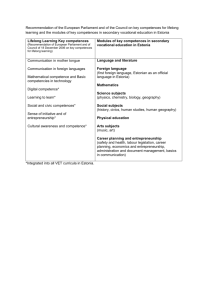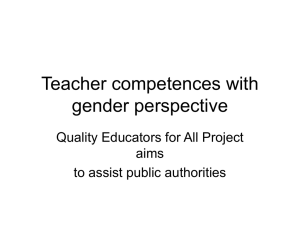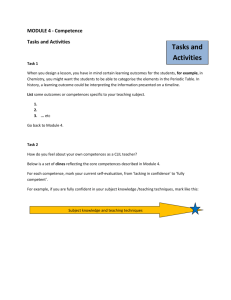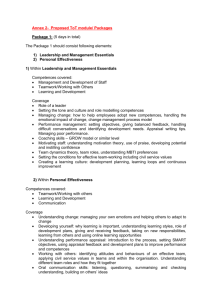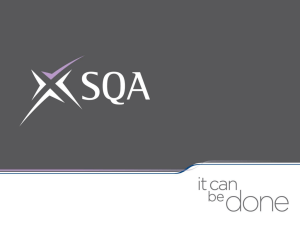SICI GA 2012 Prague
advertisement
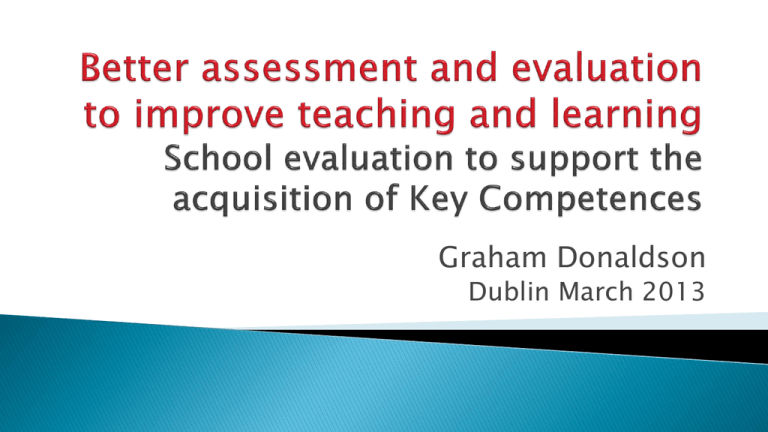
Graham Donaldson Dublin March 2013 School evaluation can serve many purposes and takes different forms in different contexts Key competences represent radical change for many education systems and will require well-targeted change strategies School evaluation can be a powerful driver but needs to be aligned with the other elements in the change strategy Issues of accountability and improvement must be resolved if it is to be fully effective. Governance Inside Ministry Distant from Ministry Purpose Focus • Accountability, control, compliance • System monitoring • Improvement – capacity building, market • Teacher • School Culture/trad itions Political environment Quality of education Resources Policy trends Enforcer Assurer ‘Best buy’ guide Mitigator of risk Catalyst/driver of change Capacity builder Agenda setter Increasing: reach and scope – alignment use of data – benchmarking, value added, qualitative data use of self-evaluation openness and transparency about criteria attention to proportionality and risk focus on learning and teaching and pedagogical leadership focus on follow-up and impact Alignment and articulation Impact on teaching and learning Consistency without uniformity – common criteria High stakes and improvement Power of quantification as against quality criteria Risk / opportunity cost / maturity Failing schools or coasting schools “..many of today’s schools have not caught up as they continue to operate as they did in the earlier decades of the 20th Century. “How can learning within and outside schools be reconfigured in environments that foster the deeper knowledge and skills so crucial in our new century?” “To succeed in this is not only important for a successful economy, but also for effective cultural and social participation and for citizens to live fulfilling lives.” OECD 2008 Leadership Teaching Evaluation Key competences Challenge orthodoxies Winning hearts and minds Implications Structural Pedagogical Assessment Package and push? Sticks and carrots? Hearts and minds? If “the quality of education cannot exceed the quality of its teachers” (McKinsey 2007) then the prime task is to build the capacity of and maximise the impact of those teachers, individually and collectively. That requires changes in culture, leadership and in the nature of the teaching profession itself. “We now know that the teacher is the most powerful influence on how much a student learns and that teachers can continue to make significant improvements in their practice throughout their entire careers” “For commitment to flourish and for teachers to be resilient and effective, they need a strong and enduring sense of efficacy…They need to work in schools in which leadership is supportive, clear, strong and passionately committed to maintaining the quality of their commitment.” Day et al ‘Teachers Matter’ OUP 2007 quoted in Hargreaves & Fullan ‘Professional Capital’ Routledge 2012 Hattie ‘Visible Learning ’ 2009 Routledge Situation Intuitive Chance bound Tacit Wikman ‘Teacher Education Policy in Europe’ 2010 Vision and purpose – quality of learning Relentless focus on capacity-building Extended professionalism/discretionary effort Flexible, impact-focused, collegiate culture Professional learning as key dynamic of innovation Talent spotting and coaching Mentoring as role of experienced teachers If teachers and leadership are the key variables in establishing key competences, then school evaluation must focus on the classroom help to identify what is happening in learning and teaching look for pedagogic leadership identify capacity issues be formative as well as summative Accountability Improvement Compliance with statute and regulations Policies and structures Procedures Quality of teaching and its impact on learning of all young people Learning context Data on outcomes Ethos Etc etc Student outcomes – key competences Quality of teaching and its impact on learning of all young people Learning context Nature of the teaching force Arrangements for and effectiveness of professional growth Role of leadership in teacher quality and development Collegiate culture of professional growth and respect for evidence Alignment with wider educational and professional policy How far a school’s self evaluation focuses on the impact of teaching on learning School evaluation: a two-way partnership schools evaluate the quality of their own provision backed up and validated by external evaluation Does it serve clearly understood purposes? How well aligned is it with wider educational and professional policy? What is the balance between self evaluation and externality? Are those involved competent? Is there a common language and are there agreed indicators/criteria? Does it focus on what matters? (if it’s not happening in the classroom it’s not happening – Elmore) Does it make a difference? (in the capacity of the school to serve its young people) School evaluation can serve many purposes and takes different forms in different contexts Key competences represent radical change for many education systems and will require well-targeted change strategies School evaluation can be a powerful driver but needs to be aligned with the other elements in the change strategy Issues of accountability and improvement must be resolved if it is to be fully effective. Graham.Donaldson@glasgow.ac.uk


